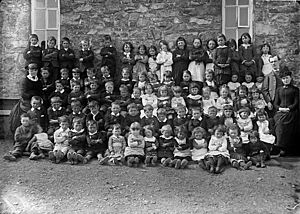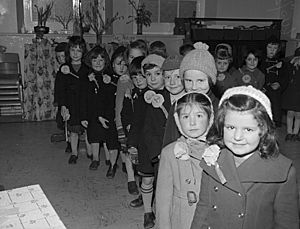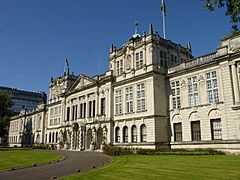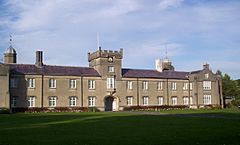Education in Wales facts for kids
| Department for Education and Skills | |
|---|---|
| Minister for Education and the Welsh Language | Jeremy Miles |
| National education budget (2021/22) | |
| Budget | £2,728.6 million |
| General details | |
| Primary languages | English and Welsh |
| System type | National |
| Compulsory education Devolution | 1880 1999 |
| Literacy (2003) | |
| Total | 99% |
| Male | 99% |
| Female | 99% |
This article tells you all about education in Wales, from when you're very young to university and learning as an adult. In Wales, most education is paid for by the government, so it's free for children at primary and secondary levels. It's a rule that children in Wales must go to school between the ages of 5 and 16.
The education system in Wales is a bit different from other parts of the United Kingdom. For example, the way the Welsh language is taught is special here.
Kids can usually start free nursery education when they are three years old. They then typically begin full-time primary school at age four and move to secondary school at age eleven. At 16, students usually take their GCSEs. After GCSEs, young people can choose to stay at school to study A-levels or go to a further education college. From the age of 18, they might decide to go to university.
In the past, formal education was only for the rich. Later, charities helped provide it, and eventually, the government took over. By the end of the 1800s, all children could go to primary school. By the mid-1900s, all children could go to secondary school too. How the Welsh language was taught in schools has changed a lot over time.
Contents
How Education in Wales Began
In the early days, schools were often run by churches or private groups. Only a few people could go. In the 1600s and 1700s, charities worked hard to help more people get a basic education.
In the 1800s, a government-run school system started. By the end of that century, education was free and compulsory for children aged 5 to 12. The age when children could leave school was raised later, and more secondary schools were built. By the mid-1900s, all children could go to secondary school.
By 1980, there were no longer separate secondary schools for students with different academic abilities. In 1999, the Welsh government took control of education policy in Wales.
How Education is Set Up
Learning for Young Children
Children can get free nursery education for at least ten hours a week after their third birthday. This usually starts in January, April, or September, whichever comes first. In nursery, children learn creativity, communication, and general knowledge. Learning to read and write isn't the main focus at this age.
Depending on their parents' jobs and income, some children can get up to twenty extra hours of government-supported childcare each week. In the 2021/2022 school year, most primary schools in Wales had nursery classes. There were also eight separate nursery schools run by local councils.
The Welsh government plans to offer free childcare for all two-year-olds by the mid-2020s. Right now, only children from less well-off families or in certain areas get 12.5 hours of care from the government.
Mandatory Schooling in Wales
A child's age on September 1st decides when they start school. Education becomes compulsory after a child's fifth birthday. This can be at home or at school. Most parents send their children to school in the "reception year" in September, so most kids start school at age four or four and a half.
Primary School Education
In 2014/15, there were 1,330 primary schools in Wales. About 273,400 pupils attended these schools, with 12,240 full-time teachers. This meant there was one teacher for every 22 pupils, and the average class size was 26 pupils.
In 2014/15, 435 primary schools taught mainly in Welsh, with 65,460 pupils.
Since September 2022, all children in the first year of primary school in Wales get free school meals. The plan is for all primary school children to get free meals by 2024.
Secondary School Education
Children usually move from primary to secondary school between Year 6 and Year 7, when they are 11 years old. In Year 9 (or sometimes Year 8), students choose which subjects they want to continue studying. They must pick subjects from different areas, but the choices vary between schools.
Maths, English, Science, and Welsh (as a first or second language) are compulsory subjects. Some schools might also make other subjects compulsory.
Students in secondary school take part in the compulsory GCSE exams at age 15/16. They can also choose to take A-levels or BTEC qualifications at age 17/18. Since 2007, the Welsh Baccalaureate Qualification has also been an option.
In 2014/15, there were 207 secondary schools in Wales with 182,408 pupils. There were 11,269 full-time teachers. This meant about 17 pupils for every teacher.
In the same year, there were 50 secondary schools that taught mainly in Welsh, with 36,485 pupils.
Wales has sometimes scored lower in the PISA tests. These tests compare how well teenagers around the world do in school. In the 2018 tests, Wales' results got better, but they were still the lowest among the four UK education systems in all subjects.
Further Education After School
Further education (FE) is for people who have finished compulsory school but are not yet at university. Young people often go to FE colleges instead of staying at school after age 16.
FE and government-funded training in Wales are provided by 15 FE colleges and other training groups. These colleges are different sizes and offer various courses. Many colleges also offer fun learning classes and training programs for businesses. In 2014/15, there were 263,315 FE students in Wales.
Adult Learning in Communities
Adult Community Learning is a type of adult education or lifelong learning. It is run and supported by local councils in Wales. These programs can be formal or informal. They can lead to qualifications or not, and they can be for jobs, academic study, or just for fun. In 2018–2019, there were 23,970 adults taking part in Local Authority Community Learning.
University Education
Students usually start higher education (HE) at university from age 18 onwards. Undergraduate students pay about £9,000 a year in fees. They can usually get student loans and grants to help with living costs, depending on their family's financial situation.
The government doesn't control what is taught at universities. However, it does influence how students are accepted and checks the quality of education through the Higher Education Funding Council for Wales.
In England, Wales, and Northern Ireland, all qualifications can be compared on a scale from Entry Level to Level 8. Level 1 is like a lower pass grade at GCSE, and Level 8 is like a doctorate (the highest degree).
Undergraduate degrees are usually the first university qualifications. They are typically Level 4, 5, or 6. Students generally need A-Levels or similar qualifications to get in. If their grades are not strong enough, they might do a "foundation year" first. The most common type of undergraduate degree is a Bachelor's degree. This usually takes three years and involves studying one or two subjects in detail. It is a Level 6 qualification.
A postgraduate degree is a Level 7 or 8 qualification. You usually need an undergraduate degree first. These degrees focus on a more specific topic than undergraduate degrees. There are "taught" degrees, which are like undergraduate courses, and "research" degrees, where students study a topic they choose more independently. A master's degree is a high-level qualification.
In 2014/15, there were 145,735 students enrolled at universities in Wales. This included 97,900 students doing their first degree and 27,780 doing postgraduate studies. Welsh universities had a total of 10,140 full-time and part-time staff.
How Education is Managed
Local Councils and Schools
In Wales, local councils oversee state schools. This is different from England, where some state schools are run directly by the central government.
Schools funded by local councils come in different types:
- Community schools are owned and run by the local council.
- Voluntary controlled schools are owned by a charity but closely watched by the local council.
- Voluntary aided schools are owned by a charity but have more freedom to run themselves.
- Foundation schools are owned by a governing body or charity with less local council oversight.
Often, the charity involved in the second and third types of schools is a religious group, like the Church in Wales or the Roman Catholic Church.
A new curriculum is being introduced in Wales from 2022. It aims to give individual schools more control over what they teach. Schools can create their own plans within a basic set of guidelines.
| Local councils in Wales |
|---|
|
Education Groups
In 2014, there were four main education groups in Wales:
- North Wales (GwE) (Flintshire, Conwy, Wrexham, Gwynedd, Isle of Anglesey, Denbighshire)
- South West and Mid Wales (ERW) (Swansea, Neath Port Talbot, Carmarthenshire, Pembrokeshire, Powys, Ceredigion)
- Central South Wales (CSC) (Bridgend, Cardiff, Merthyr Tydfil, Rhondda Cynon Taff, Vale of Glamorgan)
- South East Wales (EAS) (Caerphilly, Monmouthshire, Newport, Blaenau Gwent, Torfaen)
These groups help schools improve in their areas. This includes checking how well school leaders are doing, the quality of teaching, and student results.
The Welsh Language in Schools
In the 1800s, the Welsh language was often not allowed in schools. In the 1900s, it slowly became more important in the education system.
A good number of students in Wales are taught mainly in Welsh. In 2014/15, about 15.7% of children and young people received Welsh-medium education. Another 10% went to schools where a lot of the lessons were taught in both Welsh and English.
You can study the Welsh language at all ages, from nurseries to schools, colleges, and universities. It's also available in adult education. Learning Welsh is compulsory for all students in state schools until they are 16.
Schools have some freedom in how much English they teach children before age seven. This allows Welsh-medium schools and nurseries to teach young children in Welsh as much as possible. In later primary school years, most lessons (70% or more) in Welsh-medium schools are still in Welsh. At secondary level, all subjects except English are taught in Welsh. However, as they get older, students in Welsh-medium education must take the same English language tests as students who were mainly taught in English.








